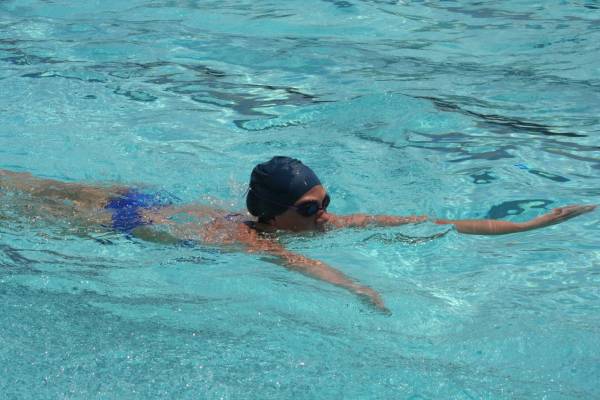As a swimmer I am biased when I say there is very little for which swimming isn’t beneficial. But even thinking objectively it is a fairly accurate statement. I recently covered the benefits of swimming as a recovery strategy between workouts for other sports, backed by peer-reviewed studies. Another area for which swimming is particularly useful is in the rehabilitation of injuries. I am using the word “injuries” here in a very broad sense, and for this article will focus on back injuries.
There are a few main reasons why swimming is a good rehabilitation tool:
- It is low impact. (Unless you are training to be an elite swimmer at which point you will be putting your body through a more intense, higher impact workout.)
- It is a form of active stretching – swimming technically will ensure full range of motion movements for many different body parts.
- It provides just enough resistance from water to provide, over time, sustained aerobic conditioning to the rehabilitating subject, allowing them to continue to workout while rehabbing at the same time.
It was a few years ago, during my “retired swimmer” career woman days that I herniated a disc from fairly intense running, which is ironic because my friends know how much I despise running, so why was I even running? But the fact remained I had a herniated disc, preventing me from further running, making walking fairly challenging, and lifting any kind of weight practically impossible. Consulting a colleague at the hospital I was given two choices: surgery or swimming. My first reaction was “No, not swimming!” Swimming to me was always associated with a structured program, “blood, sweat and tears,” and competition. I certainly didn’t want to go back to that at that point. But that wasn’t what my colleague was suggesting, and it sure sounded a lot more appealing than having surgery on my back.
 So, for the months that followed, I frequented the pool three times a week, experimenting with exercises to help me rehabilitate my back. At the end of my rehab period, and to this day, my back made a full recovery, without surgery. I run regularly without any back issues (and I mostly run against my will these days). So swimming – swimming is how I got there.
So, for the months that followed, I frequented the pool three times a week, experimenting with exercises to help me rehabilitate my back. At the end of my rehab period, and to this day, my back made a full recovery, without surgery. I run regularly without any back issues (and I mostly run against my will these days). So swimming – swimming is how I got there.
For back injuries swimming is particularly useful because swimming is not weight bearing. The water mostly supports you, and you swim close to horizontal, releasing most of the pressure associated with exercises where you need to stand. Now that pressure is not completely eliminated, and obviously the back is still engaged while you swim. Playing around with strokes can help alleviate some of this pressure further. Swimming backstroke is likely one of the best strokes for back injuries as you lay in the water in the supine position, allowing the water to support your back, in contrast to the other three strokes which are performed in the prone position.
My case was not severe and I was able to swim. In severe cases, swimming may initially not be a possibility, but getting in a pool and doing low impact exercises in an aquatic environment are a good starting point in rehabilitation. Start with getting in the water to chest level and walking the pool, eventually add some arm movement and gradually progress to full on swimming. This is a common recommendation by neurosurgeons for post-spinal surgery rehabilitation. You will also often find that physical rehabilitation facilities contain therapy pools used for low impact injury rehabilitation. These centers usually have faster rehabilitation rates than other centers.
 Interestingly, a recent study in animal models of peripheral nerve injury suggests swimming is beneficial in the rehabilitation of rats following sciatic nerve crush. In this study the authors reported swimming applied during both the acute and late phases after axonotmesis (nerve cell injury that disrupt the axon) in rats accelerated nerve fiber regeneration and synaptic elimination – a process that is activity-dependent, favors monoinnervation and subsequent recovery of physiological muscle activity – ultimately increasing the rate of recovery from nerve injury. While the same studies would be unethical to perform in human subjects, there is mounting evidence that swimming accelerate the rates of recovery of patients with back/spine injuries.
Interestingly, a recent study in animal models of peripheral nerve injury suggests swimming is beneficial in the rehabilitation of rats following sciatic nerve crush. In this study the authors reported swimming applied during both the acute and late phases after axonotmesis (nerve cell injury that disrupt the axon) in rats accelerated nerve fiber regeneration and synaptic elimination – a process that is activity-dependent, favors monoinnervation and subsequent recovery of physiological muscle activity – ultimately increasing the rate of recovery from nerve injury. While the same studies would be unethical to perform in human subjects, there is mounting evidence that swimming accelerate the rates of recovery of patients with back/spine injuries.
In the spirit of election season I would propose, “swimming for president.” But since President Obama has just been re-elected for another four years I will have to settle for proposing swimming as a prime rehabilitation tool for back injuries.






